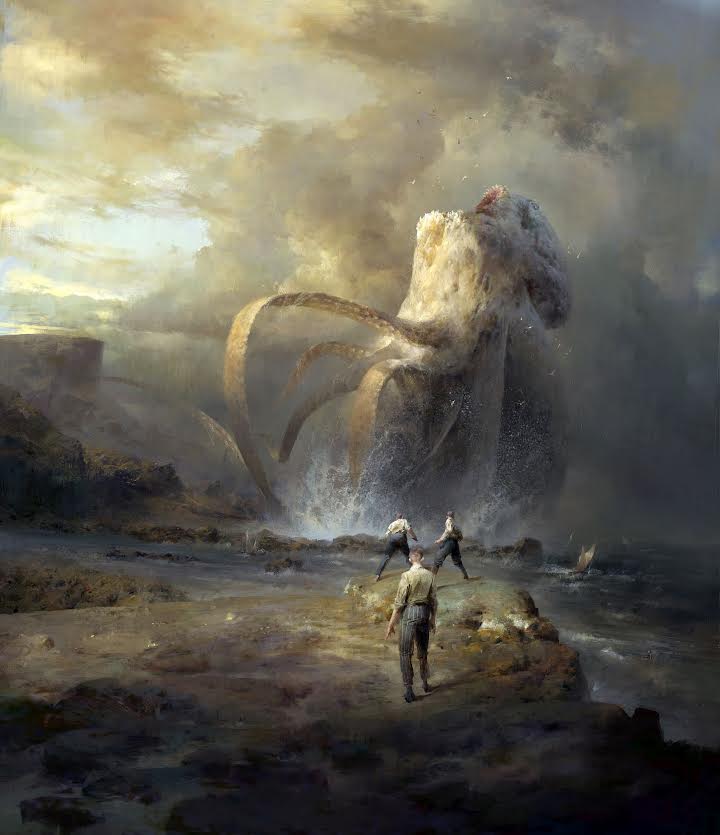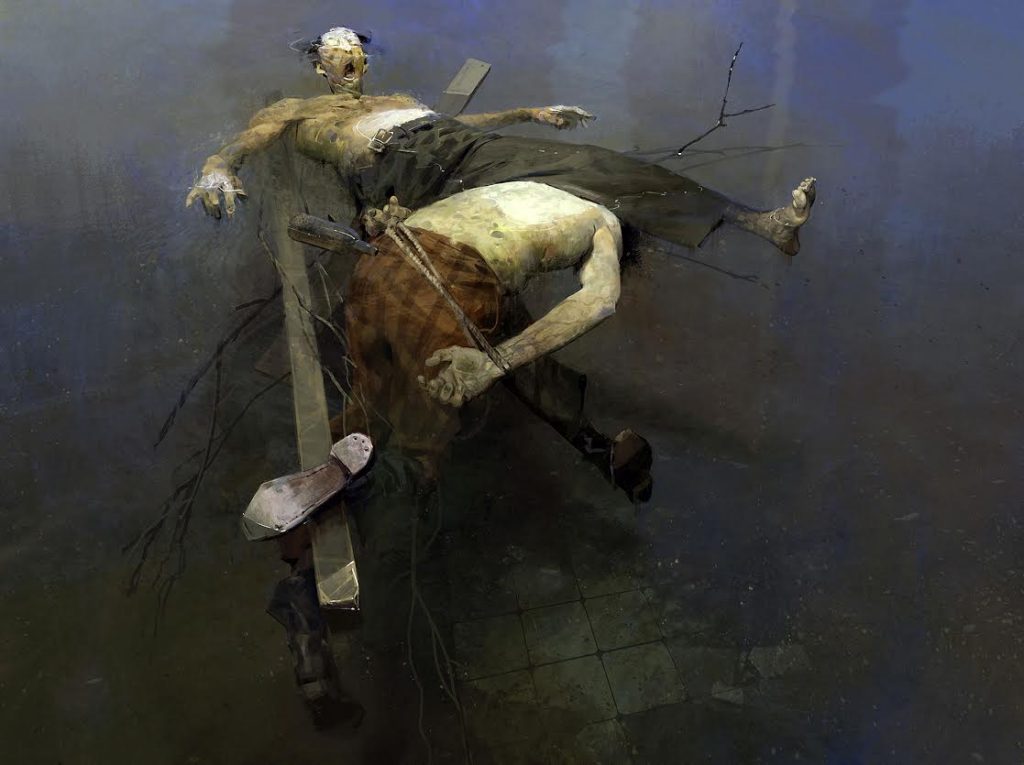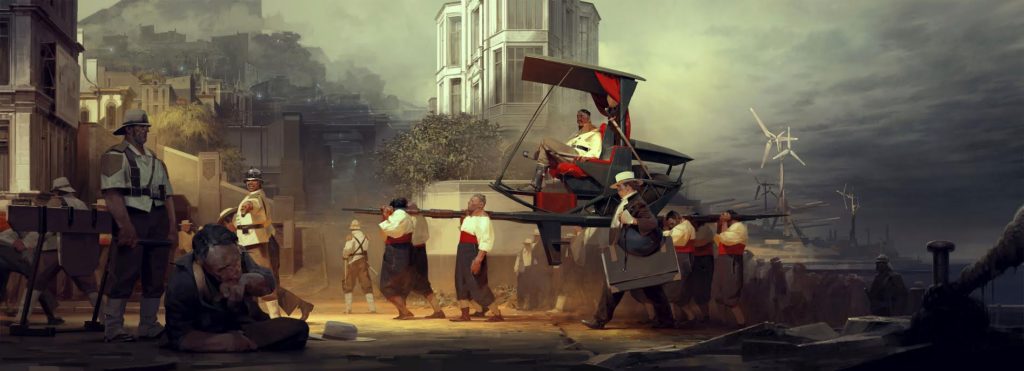It was there, in the very first shot of Dishonored 2’s gameplay debut. Shown off by director Harvey Smith at publisher Bethesda’s E3 press conference earlier this week, the game’s first true appearance opened with slatted light falling across an unfinished sculpture, the chisel marks visible in the aging hardwood, depicting some tentacled monstrosity, some creature of the deep. Beside it a painting of a knight or soldier, hunched in the shadow of a tree, atop a huge boulder and surrounded by fireflies, or perhaps hidden, glinting eyes. Both were set in a series of rich apartments, filled with entomology collections, fossils and strange brass instruments. Among this all was a woman, tapping away at the elegant shape of a distorted belle époque typewriter, under the soft breeze of a steel fan.
From this opening tableaux the presentation moved onto more concrete things: descriptions of the new setting of Karnaca, a colonial outpost of heat and dust, demonstrations of the now-empress Emily Kaldwin’s supernatural abilities, and the openly structured stealth gameplay we have come to expect. The woman, her typewriter, the sculpture and the painting, however, remained unexplained. This enigmatic opening, imbued with the hallmarks of developer Arkane’s richly-drawn world, mirror some of the strongest aspects of the Dishonored universe.
Though the first game might have been hung around a simple revenge plot, the world it inhabited emerged as a complex construction of culture, history, and ornate masonry. More importantly, the game was eager not to explain the mysteries of Dunwall and the Empire, keeping its lore terse and equally mysterious. A list of months, an account of a whaler’s voyage, fragments of a song; its documents and books only provoked more questions in the player’s inquisitive mind. The significance of that mysterious first shot, with its artworks and artefacts is that it suggests that, for Dishonored 2, Arkane are extending this approach beyond their lore and into the art of their world.
It is the same tentacled monster, or at least a creature of the same species. Snapping its jaws at the pinprick flock of birds that circle its head, it rises from the water like a Great White breaching, if a Great White were the size of a mountain. In the foreground three men stand on a rocky outcrop facing the monster. Two of them stand in shock, but the other, the one closest to us, seems to have an attitude of steely resolve. This painting, released alongside the unveiling of the game, is not your typical pre-production concept art. This artwork, and the others released alongside it, are assets from the game, art that will be found hanging in the studies and apartments of Karnaca at Dishonored 2’s November release. Elegantly hued and drawn with precise and studied brushstrokes, they suggest stories of mythical significance, historical events, and lost narratives. These are not the usual dull landscapes that line the walls of videogame interiors, but comprehensive works of art in themselves, ones that will feed into Dishonored 2’s great mysteries.

One of the paintings depicts two bodies, suspended in shallow water. Twisted around each another, bound with branches and beams, they form a surreal vignette that resembles a deconstructed crucifixion, one with no immediate explanations. Perhaps we are looking at a depiction of the great flood that befell Dunwall when the barrier broke, or a popular folktale rendered in macabre detail. Perhaps this is just an artist’s surreal flight of fancy, a dream made concrete in oils. However, this image is not just striking because of its potential web of connections with the game, but on its own terms as well.
Though there is much technically skilled and beautiful concept art in the world, most of it trades on scale, spectacle, and escapism. This piece instead possesses an intense focus, a rich symbolism and a classical attention to light and anatomy. Rather than taking fantasy tropes, romantic landscapes and cinematic grandeur as its reference points, its aesthetic points towards Goya’s rotting dead and Caravaggio’s sculpted bodies, its composition suggesting the cinema of Andrei Tarkovsky or Alexei German. This is what distinguishes the art we can expect to find in Dishonored 2: its sophistication, its awareness of references, and its refusal to be instrumentalized as simple exposition.

Arkane, it seems, are eager to ensure that Dishonored 2 is not just good art, but that it contains good art. It’s not surprising then that they have sculptor Lucie Minne on staff, or that art director Sebastien Mitton focuses his team almost exclusively on fine art influences. This focus on artworks themselves as expressive tools is so often missed in games, as developers strive to build worlds, but leave them empty; without culture, without art, without poetry of any remark.
Classical paintings and sculptures are what bring our own history to life, with all its mysteries, inconsistencies and powerful symbols. Beyond documentary and historical study, it is great art that complicates simple histories, refuses singular authorities and communicates that which lies between and beyond the facts of the past. For game worlds to be denied this influence is to leave them unfinished. Dishonored 2, however it turns out as a game, is a project uniquely sculpted to correct that imbalance.
Dishonored 2 is coming to PC, PlayStation 4, and Xbox One on November 11th 2016.

